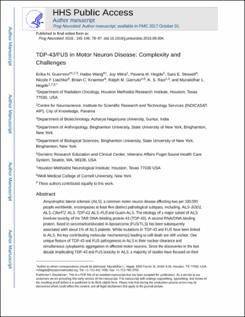TDP-43/FUS in motor neuron disease: complexity and challenges

View/
Date
2016-10-01Author
Guerrero, Erika N
Wang, Haibo
Mitra, Joy
Hegde, Pavana M
Stowell, Sara E
Liachko, Nicole F
Kraemer, Brian C
Garruto, Ralph M
Rao, KS Jagannatha
Hegde, Muralidhar L
Metadata
Show full item recordAbstract
Amyotrophic lateral sclerosis (ALS), a common motor neuron disease affecting two per 100,000 people worldwide, encompasses at least five distinct pathological subtypes, including, ALS-SOD1, ALS-C9orf72, ALS-TDP-43, ALS-FUS and Guam-ALS. The etiology of a major subset of ALS involves toxicity of the TAR DNA-binding protein-43 (TDP-43). A second RNA/DNA binding protein, fused in sarcoma/translocated in liposarcoma (FUS/TLS) has been subsequently associated with about 1% of ALS patients. While mutations in TDP-43 and FUS have been linked to ALS, the key contributing molecular mechanism(s) leading to cell death are still unclear. One unique feature of TDP-43 and FUS pathogenesis in ALS is their nuclear clearance and simultaneous cytoplasmic aggregation in affected motor neurons. Since the discoveries in the last decade implicating TDP-43 and FUS toxicity in ALS, a majority of studies have focused on their cytoplasmic aggregation and disruption of their RNA-binding functions. However, TDP-43 and FUS also bind to DNA, although the significance of their DNA binding in disease-affected neurons has been less investigated. A recent observation of accumulated genomic damage in TDP-43 and FUS-linked ALS and association of FUS with neuronal DNA damage repair pathways indicate a possible role of deregulated DNA binding function of TDP-43 and FUS in ALS. In this review, we discuss the different ALS disease subtypes, crosstalk of etiopathologies in disease progression, available animal models and their limitations, and recent advances in understanding the specific involvement of RNA/DNA binding proteins, TDP-43 and FUS, in motor neuron diseases.
